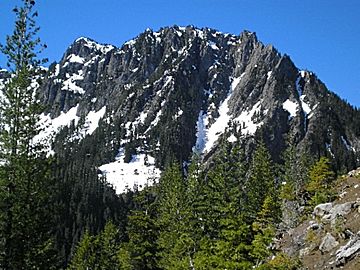Eagle Peak (Washington) facts for kids
Quick facts for kids Eagle Peak |
|
|---|---|

Eagle Peak seen from Ricksecker Point
|
|
| Highest point | |
| Elevation | 5,958 ft (1,816 m) |
| Prominence | 238 ft (73 m) |
| Isolation | 0.28 mi (0.45 km) |
| Parent peak | Chutla Peak (6,020 ft) |
| Geography | |
| Location | Mount Rainier National Park Lewis County, Washington, U.S. |
| Parent range | Cascades |
| Topo map | USGS Mount Rainier West |
| Climbing | |
| Easiest route | Scrambling class 3 |
Eagle Peak is a mountain in the Mount Rainier National Park in Washington, U.S.. It stands at 5,958-foot (1,816-metre) tall. It is part of the Tatoosh Range, which is a smaller group of mountains within the much larger Cascade Range.
The peak is located south of Mount Rainier. It is also just east of a place called Longmire. Eagle Peak used to be known as Simlayshe. This was a Native American word that meant 'eagle'. Later, a man named George Longmire changed the name to Eagle Peak.
You can hike to Eagle Peak using the four-mile Eagle Peak Trail. From the trail, you can see amazing views of Mount Rainier. Reaching the very top of Eagle Peak involves some scrambling. This means you might need to use your hands to climb over rocks. All the water that runs off the peak flows into the Nisqually River.
Mountain Weather
Eagle Peak is in a special weather area called the marine west coast climate zone. This type of climate is found in western North America. Most of the weather systems start over the Pacific Ocean. They then travel northeast towards the Cascade Mountains.
When these weather systems reach the mountains, they are forced to rise. This process is called orographic lift. As the air rises, it cools down and drops its moisture. This moisture falls as rain or snow onto the Cascades. Because of this, the western side of the Cascade Mountains gets a lot of rain and snow. This is especially true during the winter months.
Due to its mild climate and closeness to the Pacific Ocean, the area rarely gets very cold or very hot. Temperatures rarely go below 0 °F (−18 °C) or above 80 °F (27 °C). In winter, it is often cloudy. But in summer, high pressure systems over the Pacific Ocean bring clear skies.
Because of the ocean's influence, the snow here is often wet and heavy. This can create a high risk of avalanches. The best time to visit or climb Eagle Peak is from July to September. The weather is usually the nicest during these months.
More Information
- National Park Service web site: Mount Rainier National Park
- Washington Trails Association web site: Eagle Peak Trail
- Eagle Peak hiking video: YouTube


